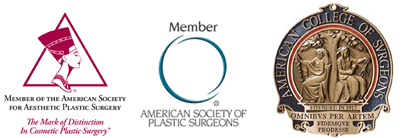How a scar or incision heals depends on factors such as the surgeon, the scar location, the operation, time, and individual human differences. These factors are discussed in this educational writing and it’s importance to cosmetic surgery results and plastic surgery scars.
A patient of mine from West Chester, Pennsylvania came to me and asked, “Get rid of my scars.” You unfortunately can’t. Scars are permanent. If a person has a laceration or an operation, the incision turns into the scar, and this scar is permanent. It will fade, however! It will become less noticeable, but it will always be there. Understanding this process is very important. Plastic surgery incisions eventually turn into scars.
The factors involved in scar fading, incision healing, and surgical results will now be discussed.
1- The Surgeon:
Everyone wants the best doctor or surgeon to sew up their cuts or lacerations. This is true of their cosmetic operations too. Usually this is the plastic surgeon. Plastic surgeons have extensive training focused on the best techniques to maximize the fading and healing of scars. The techniques used include gentle handling of tissue, meticulous hemostasis, small- delicate stitches, and precise approximation or suturing of the tissues. It is normal to want the best doctor to fix your lacerations or to perform your cosmetic operation. This will play a role in your healing. The plastic surgeon will use his extensive training to maximize the healing and the fading of the incision to give the best result.
2- The Location:
In real estate transactions, there is a phrase used often – “Location, Location, Location!!”
This applies to scars and incisions also. If we get accidentally cut or suffer a laceration, we have no choice of the location or where the cut or scar occurs. However, with operations we have a choice. The location is critically important. Certain areas on the body heal better than others. For example, the face tends to heal extremely well. I call it a “privileged” location. Face lifts, eyelifts, and other cosmetic operations on the face use incisions that almost uniformly heal exceptionally well. The incisions in these areas are placed in “privileged” areas and usually are difficult to see after healing. It is a characteristic of these operations that the scars heal extremely well. If they didn’t, these operations would not be so popular.
However, other locations don’t heal as well as the face. The back, for example, doesn’t heal as well as the face. The scars or incisions in this area tend to be thicker and wider than often desired. The knee or shoulder can heal with wider or suboptimal scars. Some areas of the body do not heal as well as others. Location is critical.
The breasts, like the face, tend to heal very well. Cosmetic surgery operations on the breast often have very nice scar fading and results because of this tendency. This is true also for the incision for an abdominoplasty or tummy tuck. These operations tend to have surgical results with nice incisions and scars that fade well with time.
3- The Operation:
Different operations will have different results and scar healing patterns. As discussed above, certain operations use incisions that are not in the best locations. Thigh lifts, body lifts, buttock lifts have incisions that might not heal as well as other operations. A person might have to except a scar that is not as good as desired or thicker or wider than desired. These locations might have a higher incidence or chance of poor healing. Other operative factors can play a role. For example, operations that have complications, infection, or delayed healing will effect the scar or the surgical result. Delayed healing beyond three weeks is often associated with hypertrophic or keloid scars. Therapy is available if this happens, so this can help the fading if it occurs.
4- Time:
Scars or incisions fade with time. It can take much longer than many people realize to see complete fading of the scar. A good rule of thumb is that scars fade over a year. However, it can take longer for some people. Scars sometimes can take 18 months or even longer. It is important to be patient. It most cases the scar will fade with time. The great majority of people will ultimately be happy about the appearance of the scar. The final surgical result awaits complete fading of the incisions.
5- Individual Differences:
Scar fading is not the same for everyone. Personal differences in skin type, quality, and healing abilities can make a big difference in the final appearance. Patients might have genetic differences that lead to better or worse healing. Some patients will be more prone to keloid scarring. If you know this is the case for you, make sure you tell me as things can be done to enhance healing.
Summary:
Cosmetic surgery requires incisions. These incisions turn into the scars. The final result of the cosmetic operation occurs after the scars have faded to the greatest degree. Scars do not go away completely. They usually heal to the point where most people are very happy with the incisions. Factors that are involved in scar healing include but are not limited to: the surgeon, the location, the operation, time after surgery, and individual differences.
I am a board certified plastic surgeon who practices exclusively cosmetic surgery. Please come in for a complimentary consultation. Details of your cosmetic procedure and your surgical plan will be discussed completely.

